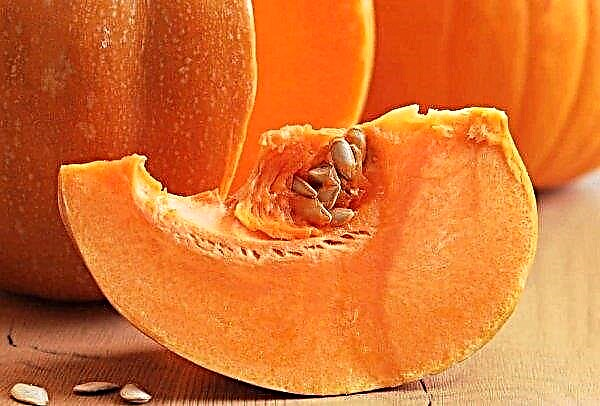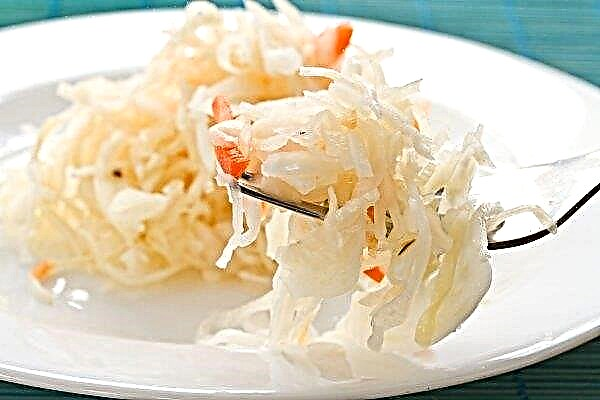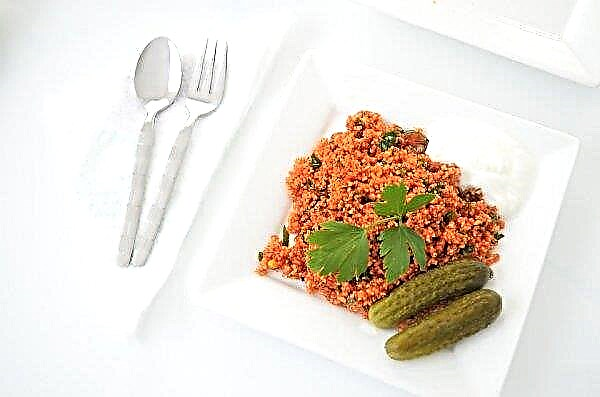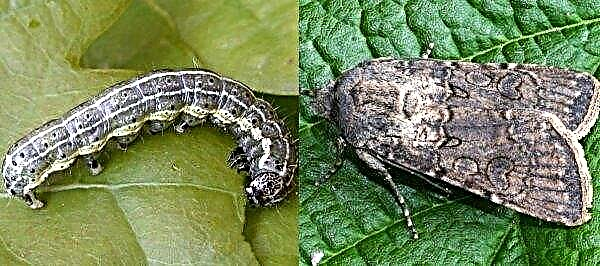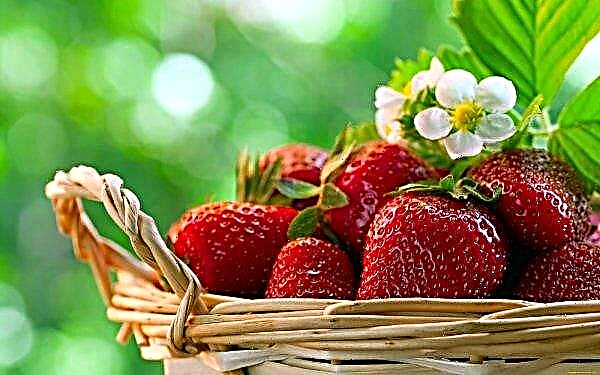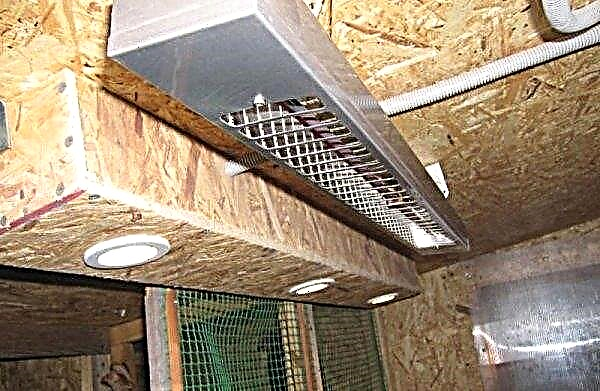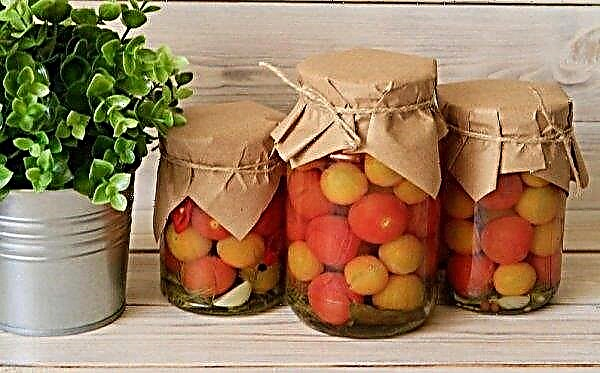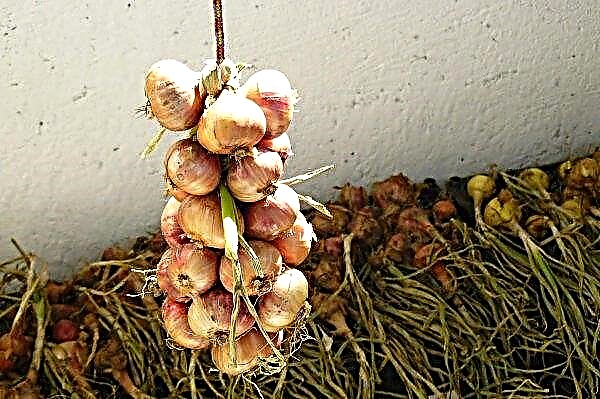Decalb White chickens are known to poultry farmers for their stamina and good egg production. How to keep these laying hens and how to feed them in order to receive large eggs all year round, we will describe later in the article.
Cross breeding history
Dekalb White appeared on the agricultural market relatively recently, but during its existence managed to gain good authority among farmers of various types.
Did you know? Every year, the world's population eats about 567 billion eggs. In this case, only the inhabitants of Germany annually consume almost 16 billion eggs, which is an average of 200 pieces for each German.
About a hundred years ago, when the breeders of the well-known in the United States of America company “Dekalb Poltri Research” tried to convey to the whole world information about the merits of their new development, advertising experts called these birds “princesses of poultry farming”.
Over time, the promising slogan was fully justified - despite the youth of the breed, it quickly spread throughout the world and, moreover, occupied a leading position in the ratings of egg productivity. Owners of large bird production gave her special preference. Today, developers continue to improve the positive qualities of cross-country, focusing on increasing the mass of eggs, and at present it is the Dekalb chickens that give record figures for egg productivity.
Today, developers continue to improve the positive qualities of cross-country, focusing on increasing the mass of eggs, and at present it is the Dekalb chickens that give record figures for egg productivity.
General characteristics
Many poultry farmers consider breeding this cross to be very profitable, because chickens give a high-quality product year-round, without requiring special conditions for maintenance and needing a small amount of feed.
And although they are not much different in appearance from their relatives, they nevertheless hold primacy in prevalence. What was the reason for this, let's understand in more detail.
Appearance
The breed standard provides a clear exterior, deviations from which are considered disqualification of the bird. It is necessary to know the features of the appearance of thoroughbred chickens so as not to fall on the hook of unscrupulous sellers-poultry houses.
The table below will help you with this:
| Features of the appearance of Decalb White chickens | |
| Head | small (smaller than average size) |
| Crest | leaf-shaped, bright red, large, often hanging to one side, covering one eye (the size of the crest of the Decalba surpassed even their close relatives, Haysekov) |
| Beak | small, strong, dirty yellow |
| Eyes | dark or brown red |
| Neck | short and wide |
| Chest | protrudes slightly, slightly rounded |
| Torso | compact, medium size |
| Stomach | quite voluminous |
| Skeleton | easy |
| Wings | small |
| Tail | long but not very lush |
| Back | not wide, thin |
| Paws | short but steady |
| Plumage and color | white, feather cover is not thick, but dense (during maximum egg laying, chickens look stripped due to nutrient deficiency) |
Productive qualities
The Dekalb White breed represents the egg type of chickens and today demonstrates maximum egg laying rates. But along with this dignity, the representatives of the cross in question are poor hens and possess skinny carcasses.
Important! To determine the freshness of a chicken egg at home, you need to dip it in a glass of water - the fresh product will drown, and the stale one will pop up.
More detailed information on the productivity of thoroughbred birds is presented in the table below.
| Decalb white chicken performance | ||
| Weight of adults, kg | Chicken | 1,5–1,7 |
| rooster | 1,8–2,5 | |
| Weight of daily chicken, g | 40 | |
| Breed direction | egg | |
| Puberty | 4.5–5 months (peak laying occurs at 40 weeks of life) | |
| Average annual egg production | about 330-350 eggs | |
| Egg quality | weight g | 60–63 |
| shell color | light coloured | |
| shell quality | strong | |
| Taste quality of meat | high | |
| Instinct of incubation | very low (it is not profitable to plant such a brood hen because of the loss of about 22 eggs that she could lay during this time) | |
| The safety of the livestock,% | young animals | 99,4 |
| adults | 96,5 | |
Important! Experienced poultry farmers advise to buy a purebred rooster in another farm once a couple of years to preserve the main features of the Dekalbov breed.
Temperament
Representatives of the Dekalbov breed differ:
- peacefulness;
- calm disposition;
- moderate activity.
 These chickens never arrange bloody fights between themselves and get along well with other animals in the yard. On farms of a large industrial scale, they feel good at the cage maintenance, and on private farmsteads they do not show aggression at free range.
These chickens never arrange bloody fights between themselves and get along well with other animals in the yard. On farms of a large industrial scale, they feel good at the cage maintenance, and on private farmsteads they do not show aggression at free range.However, a significant flaw in chickens is their poor adaptation to new conditions and low stress resistance. In addition, the described birds are characterized by increased timidity and, therefore, because of this they can bring discomfort with their loud clucking.
Advantages and disadvantages
Regardless of the purpose of breeding chickens, the choice of breed always requires a thorough analysis of all its advantages and disadvantages.
- Benefits
- high egg production (especially in the first years of life);
- precocity
- good egg quality (large size, appropriate weight and satisfactory shell density);
- almost one hundred percent livestock survival;
- friendly disposition;
- a small need for feed (in adults, the daily serving of food does not exceed 100 g);
- high immunity, resistance to common chicken diseases;
- undemanding to the conditions of detention.
- disadvantages
- poor adaptability to new conditions (especially painful Dekalby react to a change in their usual environment);
- low stress resistance;
- excessive shyness;
- noisiness
- poorly developed maternal instincts;
- unsuitability for meat purposes.

Content Rules
Although the Dekalbes have their drawbacks, their maintenance will not disappoint even novice farmers. The bird of this breed is quite unpretentious and for minimal attention will thank the owner with good indicators of egg production.
Did you know? The ranking of the most amazing chicken breeds is led by rare representatives of the Indonesian Ayam Tsemani. They differ completely black plumage, claws, skin and comb. Even the meat and internal organs of the original birds are also black. By the way, this color does not fade after prolonged heat treatment. Many people believe that black birds bring eternal success to their master, so they are ready to pay 5 thousand dollars for a couple.
And in order to achieve the most comfortable conditions for her, it is necessary to properly equip the house and the walking area, as well as comply with the diet.
Bird house
Unlike other relatives, Decalb White chickens do not require much space and can provide high productivity even in cramped conditions. The main thing is that for every square meter of the chicken coop there should be no more than 5 adults.
Such a landing will allow the bird to feel comfortable in the cold season, without reducing its egg production.
When arranging a bird house, it is important to take care of good ventilation and the absence of drafts. Otherwise, wardship diseases cannot be avoided. Windows are ideal for ventilating such rooms, but in order to save energy, they need to be equipped with sealed double-glazed windows. Before the onset of cold weather, experienced poultry farmers advise checking the walls and ceiling of the room for cracks and insulating the structure. In the autumn-winter period, the air temperature in the house should correspond to the level of 15-17 ° С.
Before the onset of cold weather, experienced poultry farmers advise checking the walls and ceiling of the room for cracks and insulating the structure. In the autumn-winter period, the air temperature in the house should correspond to the level of 15-17 ° С.
If the thermometer goes down, the wards may have a significant decrease in oviposition. In order to avoid this, it is recommended to equip the chicken coop with heating devices or infrared lamps. It is important not to forget about the fire safety requirements.
It will also be useful to examine the sex, making sure that the chickens do not have neighbors in the form of rodents. In addition, it definitely needs flooring in the form of sawdust or straw from boneless crops. The same litter is suitable for nests, which should be enough in the chicken coop - at least 2-3 for 10 individuals.
Perches for chickens should be strong, it is desirable to make them of wood. If there are many individuals in the chicken coop, then a multi-tiered arrangement of poles is allowed. The main thing is that the birds sitting on the upper ranks do not get dirty with litter of neighbors from below.
In addition, feeders and drinking bowls are required from the internal utensils in the chicken coop. They can be made in any configuration, but must be placed in a separate well-lit area. It is unacceptable that water stagnate in the containers or remain food remains.
Did you know? The color of the lamp affects poultry in different ways. For example, blue calms birds, orange stimulates the reproductive system, green promotes growth, and muted red prevents laying hens to peck eggs.
It is also important to replace the litter on the floor and in the nests as necessary.
Patio for walks
Each species of poultry requires a space for walking for full development. To protect the wards from wild relatives who are carriers of infections, this territory should be fenced with a grid from the sides and from the top.
The size of the enclosure is calculated based on the number of birds: the main thing is that the walking area does not hamper their motor activity.
It is advisable to pre-sow the allotted area with any grass suitable for grazing chickens - alfalfa, clover, sainfoin, goatskin, amaranth, lawn mixture, knotweed, barley, mustard. It is also important to leave an ash zone inside, where klush will carry out swimming.
Experienced poultry farmers are advised to supply a special tank for this purpose and fill it with a mixture of sand, wood ash and fine grain taken in equal parts.
An important detail of the walking yard is a canopy, under which the wards can hide from the sun or from the rain. Drinkers are also needed. Some breeders plant high shrubs on the north side, which will provide chickens with shade and protect them from the wind.
Feeding troughs and drinking bowls
The range of farm products for poultry equipment today amazes even the most demanding customers with its wealth. But it’s much cheaper to build a drinker and feeder on your own. However, the origin of these containers does not matter at all to the birds: the main thing is their practicality and convenience. Experts advise you to choose wooden feeders for dry food, and metal or glass vessels for wet mash. Lattice structures are ideal for fresh or dry greenery.
Experts advise you to choose wooden feeders for dry food, and metal or glass vessels for wet mash. Lattice structures are ideal for fresh or dry greenery.
In addition, when choosing such utensils, the shape of the containers should be taken into account. For example, rectangular flat trays with low sides are designed for feeding and watering chickens, as adults will climb inside and scatter the contents.
Gutter-shaped structures with bounding removable grilles and special compartments for different types of food should be located outside the enclosures, providing for access for pets to them. There are also variations of hopper feeders, which greatly facilitate the process of their maintenance (can be filled once with a daily portion).
For large poultry farms, the best option for drinking bowls is the nipple system. By the way, it can also be built at home by drilling holes in a plastic bucket and equipping them with nipples.
Did you know? The best taste is characterized by the French breed of hens La Bresse Gauloise. She is known for being the only owner of the AOS quality mark since 1957. For the sake of this bird, a magnificent chicken show is organized annually in the country, where farmers have the opportunity to compete in the competition for the best carcass, which is very prestigious to win. In addition, each manufacturer is encouraged by a cash prize of 10 thousand euros.
In the chicken coop, feeders and drinking bowls are placed under the lamps in a place remote from the recreation area. Depending on the mounting methods, they can be placed on the floor or hung with brackets to a vertical support. The main thing in choosing such containers is to comply with the following requirements:
The main thing in choosing such containers is to comply with the following requirements:
- Vessels for feeding and drinking chickens should be made in such a way as to exclude the possibility of birds to climb inside, scatter the contents and contaminate it with its paws.
- Drinking bowls and feeders should be as simple as possible to maintain (as necessary, you will have to free them from the rest of the feed, wash and change the water).
- The containers are considered ideal if they are not cramped for pets (they are calculated by leaving a distance of about 15 cm for each adult), lightweight, their shape and size do not interfere with regular washing and cleaning.
Seasonal molt
Unlike other chicken breeds, Decalbes do not stop rushing even during seasonal molting. At the peak of oviposition, they lose many feathers, which is not the best way affects their appearance.
Under adverse conditions, the birds can only slightly reduce the intensity of the process, or the quality of the eggshell will decrease. That is why veterinarians advise to strengthen the nutrition of chickens and take care of their comfort in such a period.
The breeder should know that:
- the first chicken molt begins at 4 weeks of life, when a feather appears instead of fluff in chickens;
- the second molt is expected at the age of three months, when the young appear contour feathers;
- the third molt occurs in the spring and is considered normal for young individuals who are not yet 1 year old;
- subsequent molting should occur annually in the fall (a full plumage change will take about 6-8 weeks).
 According to experts, despite the unpresentability of molting Decalbes, individuals that intensively discard old feathers have the greatest value. If the chicken begins to molt since the summer and at the same time reduces its egg laying, you should pay attention to its state of health.
According to experts, despite the unpresentability of molting Decalbes, individuals that intensively discard old feathers have the greatest value. If the chicken begins to molt since the summer and at the same time reduces its egg laying, you should pay attention to its state of health.During the period when mass shedding begins, it is recommended to enrich the nutritious diet of the wards with compound feed (must contain at least 22% protein) and additionally with protein complementary foods (fish, earthworms, legumes), as well as dairy products, cabbage, meat and bone meal, greens.
Important! Decalbs can prematurely molt can cause stress, poor nutrition and health problems..
How to feed an adult herd
High oviposition rates of the described cross are largely dependent on the nutritional value of its diet. Decalbes eat quite a bit, so the breeder must wisely balance in a small amount of food all the vital components for the birds.
To this end, experts advise:
- from the beginning of oviposition until the onset of its peak, gradually increase the daily portions of feed (by about 40%), as well as carry out its qualitative change;
- during the period of maximum productivity, make sure that the amino acid composition is increased in the pet food (approximately 7% more than usual);
- it is preferable to add ground grain to wet mixers (its particles should not exceed a diameter of 0.5–3.2 mm);
- give food in 3 doses, while leaving about 60% of the daily portion for the second half of the day;
- arrange nightly snacks for chickens by arranging additional lighting for 2-3 hours at the right time. This will protect them from underweight;
- take care of round-the-clock access of birds to fresh drinking water.Keep in mind that in hot weather, the need for chickens to drink doubles;
- regularly mix vitamin and mineral supplements into the feed.

Addiction to disease
Decals are characterized by strong immunity, however, due to their high productivity, they are often exposed to various diseases.
Among the most common veterinarians are:
- Helminthiasis - in birds of this species, roundworms and larvae of nematodes are most often found. Progressive disease is indicated by: refusal of food, weakness, exhaustion, signs of diarrhea, as well as paleness of the crest and catkins. It is important to immediately begin therapeutic measures in relation to the entire livestock, which consists in taking medications. Typically, in such situations, “Pirantel”, “Febtal”, “Avatek”, “Filiksan”, “Phenothiazine”, “Levamisole” are mixed in with drink or wet food (the dosage and number of doses can be found in the instructions).
- Avitaminosis - occurs due to unbalanced nutrition, severe depletion due to continuous oviposition and the presence of a pathogenic environment in the internal organs of the bird. It is characteristic that diagnosing this ailment at home is very difficult, because its symptoms have many similarities with other pathologies. Usually observed in such a chicken: lethargy, decreased appetite and motor activity, rapid breathing, attacks of paralysis. To get rid of the disease, you will need a radical adjustment of nutrition with the addition of fruit, vegetable and protein components, as well as the injection of vitamin-mineral complexes. You should be prepared for the fact that vitamin deficiency is treated very hard, and a full recovery can occur only after a year.
- Colibacillosis - is an acute infectious disease to which chickens are more susceptible to two months of age. The disease is expressed by a sharp increase in body temperature (up to 44 ° C), wheezing during movements, poor appetite, lethargy, and intense thirst. Therapy consists of taking Lexoflon or Enronit antibiotics.
- Pasteurellosis - applies to chickens of any age and in most cases ends in death. The onset of the pathology can be easily recognized by the heat that has begun (body temperature often rises to 43.5 ° C), decreased motor activity, mucous-foamy discharge from the nasal openings, wheezing, shortness of breath, complete refusal of food, and also a red condensed rash that appears on the crest. In this case, it is important not to lose time, because the disease develops very quickly. The livestock can only be saved with antibiotics (Levomycetin, Tetracycline, Avidox, Spelink, Floron, Doxycycline).
- Smallpox - manifested by red small spots in the beak area. In the future, smallpox rash spreads throughout the body, and merges together in non-feathered areas, forming elastic growths. Disease can only be avoided by timely vaccination. To do this, use such drugs: CT Diftosec, Nobilis, FOWL Pox.
- Keratoconjunctivitis - appears under poor conditions when the bird lives in crowded conditions. The beginning of the pathology is indicated by reddened eyelids and respiratory tract, shortness of breath, swelling. The treatment for the disease is to create an appropriate landing for the livestock.
- Cannibalism - this phenomenon contradicts the calm disposition of the Dekalbov, but occurs under conditions of long daylight hours, excessively bright illumination of the chicken coop or a deficiency of mineral and vitamin substances in the composition of the usual feed. Moreover, such attacks of aggression more often occur in females than in males. The pecked places need to be treated with iodine solution and tar.
Did you know? Periodic darkness matters to all birds, without exception. At this time, bone tissue forms, calcium metabolism changes (which is important for the strength of the shell), immunity factors are developed.
Breeding chicks
Due to the underdeveloped maternal instincts of chickens, Decalb never lay on their eggs. Breeding at home is done by laying eggs under other chickens, and on an industrial scale using an incubator.
Egg incubation
The ripening period of the embryo in the egg lasts 20-21 days. But the success of hatching depends on the temperature of the incubator, air humidity and the quality of the eggs selected.
Experienced poultry farmers know that only fresh specimens that are no more than 5 days old are suitable for reproductive purposes. In addition, they should be characterized by the same size, integral shell and the absence of any visual defects.
If possible, it is advisable to recheck the selected eggs on an ovoscope. Thus, two-yellowness, dark-gray spotting under the shell, fungal manifestations, and death of the embryo can be detected. A thorough examination of the eggs will reduce the number of "talkers" and painful newborn chickens.
After checks, it is recommended that all suitable specimens be disinfected with Ecocide, Glutex, Virocide, or potassium permanganate, and only then they are placed in an incubator. It is important to ensure that, when closed, the lid of the container does not damage large Decalb eggs.
It is also worth taking care of humidity at the level of 60–63% and temperature conditions. Please note that the maturation of embryos and hatching of chickens should be carried out in conditions close to natural. Overheated chicks will hatch very quickly, but will be small and frail. And an unheated brood will have difficulty healing the umbilical cord. Specialists divide the entire process of incubation of chicken eggs into 4 stages:
Specialists divide the entire process of incubation of chicken eggs into 4 stages:
- Lasts the first week from the moment of laying the selected specimens in the incubator. During this period, the embryo begins its formation.
- It starts 7 days after laying eggs and lasts 4 consecutive days. It has high requirements for air humidity control. At this stage, dryness in the room is strictly unacceptable.
- It lasts from the 12th day of laying eggs until the first sounds of hatching, but already formed chickens, appear. At this time, under the shell, the processes of gas exchange and metabolism are being established.
- Hatching chicks. At this stage, it is important to examine each individual that has been born, making sure of the clarity and convexity of his eyes, the softness of the umbilical cord, the absence of a sagging abdomen - these should be healthy Decalbs.
Important! Representatives of the Dekalb White breed are characterized by a short period of effectiveness. To maintain good egg production, the stock should be completely renewed every 2 years.
Baby Care
Chickens of all breeds of chickens require special attention in the first 10 days after hatching. To do this, the breeder must arrange in advance a special warm and dry paddock outside the house. It is important to provide good ventilation in it, but to exclude even the slightest drafts.
Experienced poultry farmers know that for every square meter of the allocated room there should be no more than 20 newborn chicks. After 6 weeks, the landing will need to be reduced to 17 goals in the same area, and after 12 weeks - by 10 individuals. Initially, up to five days of age, the brood is placed in a spacious wooden box with a paper covered bottom and covered with a grill on top. During this period, it is extremely undesirable to sprinkle the litter with the chicks, as their sensitive paws are still very vulnerable.
Initially, up to five days of age, the brood is placed in a spacious wooden box with a paper covered bottom and covered with a grill on top. During this period, it is extremely undesirable to sprinkle the litter with the chicks, as their sensitive paws are still very vulnerable.
In addition, under such conditions, the bird will see better food, so immediately it is advisable to feed small Decalbes with millet or corn grits.
The box with chickens at night needs to be additionally heated with infrared lamps, and in the daytime in sunny weather to take out onto the street. In the first week of life, a temperature of 29–30 ° C is comfortable for the brood, and as the young growth grows, it can be gradually reduced to 26 ° C.
When the chickens turn 4 weeks old, they can be kept at 18 ° C. Even with a brood, young offspring are gradually trained to walk.
Chicken Diet
The uniqueness of the white Dekalb chicks lies in their miniature forms and fragility of the body. However, under the right conditions, chickens intensively gain weight, grow stronger and fully develop, demonstrating the high safety of the livestock. To help young animals grow stronger, experts advise organizing proper nutrition from the first days.
And for this you need to be guided by the following recommendations:
- In the first 10 days after hatching, chicks should be fed with hard-boiled eggs, cereals, and chopped greens. Do not forget about the small feed requirements of the breed, therefore, in order for the diet to be balanced, it is advisable to teach the brood to mixtures.
- From the 10th day of life, you need to gradually remove the egg ingredient, replacing it with compound feeds. It is important that the composition of the selected product was not less than 22% of the protein term.
- During the growing up period, the chickens are fed with grain. For better assimilation, it is recommended to mix it with finely chopped greens. In addition, such young animals can already be given fish oil every day (the daily dose is 1 g for each chicken).
- You need to add boiled root vegetables to the diet of little Decalbes, and from eight weeks of age they can be given raw.
- Make sure that the chicks have access to drinking water. It should be clean and not cold.
- Do not forget about regular disinfection of drinking bowls and feeders.
 Chickens of Dekalba will please their owners with high rates of egg production, especially since for this they need enough elementary conditions of detention and minimal attention of a person.
Chickens of Dekalba will please their owners with high rates of egg production, especially since for this they need enough elementary conditions of detention and minimal attention of a person.Important! Adult chickens require constant replenishment of calcium in the body, since a fair amount of it is spent on the formation of an egg shell.
We hope our article helps you ensure high productivity for your house.


